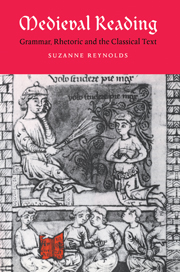Book contents
3 - Reading and the trivium arts
from Part I - CONTEXTS FOR READING
Published online by Cambridge University Press: 22 September 2009
Summary
Dicitur autem gramatica [sic] a gramaton quod interpretatur literalis et gramaton a grama que est linea. Fiunt enim littere secundum protractionem linearum. Dicitur ergo hec ars gramatica, idest litter-alis, quia litera[li]ter efficit, vel quia agit de litteris, non quia ubique sed quia in eius principio et tota eius doctrina surgit a litteris. Sicut dicitur liber genesis, non quia ubique agatur de generatione mundi sed tantum in principio.
Gramatica thus derives its name from the word gramaton which means ‘literal’ and gramaton is itself derived from the word grama which means ‘line’. For letters are indeed formed through the extension of lines. Therefore this art is called gramatica, which means to do with letters, because it does its work literally, or because it treats of letters. Not however that it does this everywhere, but because in its initial stages it treats of letters, and because the whole of its teaching arises from letters. Just as the Book of Genesis is not so called because the creation of the world is treated throughout, but because it deals with this in the very first part. From the Circa hanc artem, anonymous Priscian commentary, third quarter of the twelfth century
GRAMMAR, RHETORIC AND READING
The letter is the foundation of grammatica. It is the basis of language and of the art, for parts of grammar and the parts of language are identical: the letter (littera), the syllable (syllaba), the word (dictio) and the phrase (oratio).
- Type
- Chapter
- Information
- Medieval ReadingGrammar, Rhetoric and the Classical Text, pp. 17 - 42Publisher: Cambridge University PressPrint publication year: 1996



